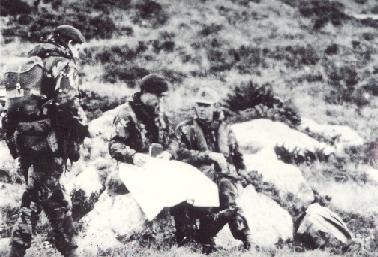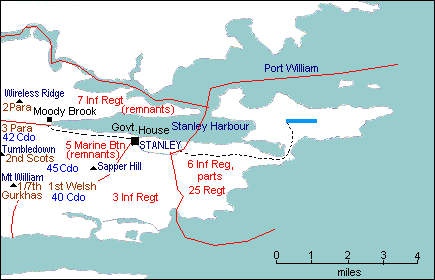As dawn broke on Monday 14th, and the Scots
Guards
completed the capture of Tumbledown, 2 Para on Wireless
Ridge saw the
Argentines streaming back to Stanley as the
British artillery shelled their positions at
will. The British forces now edged forward.
Under Brigadier Thompson (pictured
below at an earlier stage in the campaign), 2 Para moved off along the Stanley
road followed later by 3 Para; 42 Cdo shortly flew forward from
Mount Harriet and marched towards Stanley; and 45 Cdo yomped from Two Sisters for
Sapper Hill. By nightfall all of 3
Cdo Bde was close to the capital. With
5th Infantry, the Gurkhas were ready to make a
daylight attack on Mount William, but the Argentines
disappeared and D Coy moved onto the summit that
morning without any opposition. Meanwhile the Welsh
Guards were
delayed by minefields on their way to Sapper
Hill, but then flew in with A and C Coys 40 Cdo to face slight enemy
resistance just as 45 Cdo showed up.
2 Para was the first unit to reach the
outskirts, but halted as surrender negotiations got
underway. These lasted for much of the day, and as they
proceeded, British forces were ordered not to fire on the
apparently demoralized enemy. However even now, General
Menendez had 8,000 troops in the Stanley area including
the largely intact 3rd, 6th and 25th Inf Regts, still
well supplied with food and small arms ammo, but with
little left for their remaining artillery and with all
the high ground taken. Although ordered by Galtieri that
morning to continue the fight, Menendez decided to
negotiate, and a small British team led by Lt Col Rose of
the SAS helicoptered in. A surrender document covering
enemy forces both on West and East Falkland was agreed at
the end of the afternoon,
and that evening,
General Moore flew to Stanley for the official signing.
Timed to take effect from 9.00 pm
local time, the actual signing took place at 9.30 pm or half an hour into the 15th,
Zulu time. First into Stanley next morning was 2 Para,
followed by 3 Para and
42 Cdo, whose men of J Coy, last there
with NP 8901, later hoisted the Governor's flag over
Government House. With 3 Cdo Bde staying in the Stanley area, most of 5th
Infantry
returned to Fitzroy,
although the Gurkhas went to Goose Green where they later
lost a man killed on battlefield clearance.
With the surrender of the
Argentines around Stanley, and their transfer to the
airfield as a POW camp, steps were taken to deal with the
forces on West Falkland and far away on Southern Thule.
Still on Tuesday 15th, B Coy 40 Cdo crossed over to Port Howard by ship and helicopter to take the
surrender of the 5th Inf Regt, and "Avenger's"
Lynx landed a small party at Fox Bay to deal with the 8th Regt, after which all
the POW's moved to San Carlos. To re-take Southern Thule
in "Operation Keyhole", frigate
"Yarmouth" and RFA "Olmeda" reached
South Georgia from the TEZ on Thursday 17th to pick up men of M Coy 42 Cdo under the command of Capt Nunn RM,
some of whom had already left with "Endurance"
and tug "Salvageman". Arriving off the bleak
shores on Saturday,
"Endurance'" Wasp landed a small group near the
Argentine base, and when "Yarmouth" arrived
(with "Olmeda") to provide gunfire support on Sunday 20th June, the tiny remaining garrison on
Southern Thule surrendered without a shot being fired.
Needing food and shelter
for his own men, a priority for General Moore was to ship
home the POW's, with the exception of around 500 senior
officers and technicians held as a guarantee against the
junta fighting on. Both "Canberra" and
"Norland" loaded a thousand POW's at San Carlos
Water before heading for Stanley. There,
"Canberra" took on board a further 3,000,
leaving for Argentine on Friday 18th to be escorted into Puerto Madryn next day
by destroyers "Santisima Trinidad" and
"Comodoro Py". "Norland" sailed from
Stanley on Friday
with a total of 2,000 POW's to arrive off the same port
two days later, and many of the remaining Argentines
followed in the icebreaker "Bahia Paraiso". The
"specials" returned on "St Edmund" a
month later.
Even with their losses
during the fighting, the Argentines left behind
considerable amounts of war material including artillery
and armoured cars, missile and radar systems, and
aircraft and helicopters in various states of repair,
some of which returned to the UK for evaluation or
integration into the Services. And apart from recovering
the two Falkland's coasters "Forrest" and
"Monsunen" for local duties, the Royal Navy
took over two other small craft.
CAPTURED
IN STANLEY AREA
Aircraft
- 11 FAA Pucaras,
3 CANA Aermacchi MB-339A's
Helicopters
- 2 FAA Bell
212's, 1 PNA Puma, 1 Army Chinook, 2 Agusta A-109A's,
and 9 Iroquois UH-1H's
Ships - small oil rig tender
"Yehuin" (renamed "Falkland
Sound") and PNA patrol craft "Islas
Malvinas" (manned by men of destroyer
"Cardiff" and renamed "Tiger
Bay")
As the
Task Force
ships started entering Port William and Stanley Harbour, the minesweeping trawlers moved in to
successfully sweep a field of contact mines laid off Cape
Pembroke. On land, the situation was far worse as apart
from the Army having to clear all the battlefield litter
and discarded ordnance, the Royal Engineers had to deal
with the extensive and mainly unmarked minefields
especially around Stanley. (There are doubts if the work
will ever be finished.)
As for the islands
themselves, the British Government was committed to their
defence in a policy referred to as "Fortress
Falklands". If large and continuing expenditure and
large, permanent garrisons were to be avoided, rapid
reinforcement by air was vital. A first step came on the 24th June when an extended range Hercules
landed at Stanley airfield. Then in October, after its lengthening and
re-designation as RAF Stanley, the airport could be used
by Phantom fighters. But that was still not enough. A
major airfield and associated installations were
therefore constructed near Pleasant Peak. Completed in 1985, Mount Pleasant airport is able to
handle wide-bodied, long-range jet transports capable of
reinforcing the Falklands at short notice.

Sitting,
Brigadier J H Thompson RM
commanding officer, 3 Commando Brigade and
Major General Moore, Commander, Land Forces,
Falkland Islands
(Courtesy - Royal Marines
Museum)

